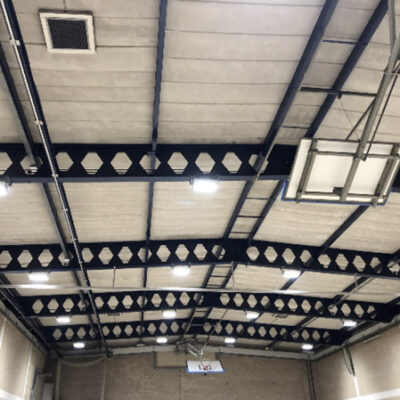Ministers are urgently asking for details about a “crumbly” type of concrete used widely in flat-roofed school buildings, often hidden from sight but now feared to be leaving schools “liable to collapse”.
Jessica Hill investigates…
How widespread is the problem?
The collapse of a primary school’s flat roof in 2018 – luckily at a weekend and resulting in no casualties – is believed to have brought the potential danger of reinforced autoclaved aerated concrete’s (RAAC) fragility into sharp focus.
While RAAC may look like traditional concrete, it is weaker, with chocolate Aero-like bubbles. Because the concrete is often obscured from view above ceilings, schools are often unaware of its presence.
But this September, the Office for Government Property (OGP) issued a safety briefing notice to all property leaders warning RAAC is “now life expired and liable to collapse”.
They warned “this has already happened in two schools with little or no notice”.
In the incident that prompted concerns about RAAC in schools, at Singlewell Primary School in Gravesend, signs of structural stress only appeared 24 hours before the roof gave way.
It happened above the school staff room, also damaging toilets, ICT equipment and an administration area. The collapse prompted Kent Council to write to other local authorities warning them to check for RAAC in their schools.
A 2019 safety alert from the Standing Committee on Structural Safety on the “failure of RAAC planks” recommended all those installed before 1980 were replaced.
DfE claims ‘not all RAAC is dangerous’
But while the government has pledged to eradicate them from hospitals, it has not made the same assurances to schools.
In fact, the information for schools applying for grants in next year’s condition improvement funding round says that “not all RAAC is dangerous”.
The concrete has nonetheless moved up the Department for Education’s priority list. DfE has recently updated guidance to schools on identifying and managing RAAC amid concerns it is little understood, and that many remain unaware the problem exists in their buildings.
But the department is also in the dark. In March, responsible bodies of state-funded schools were invited to complete a survey so ministers can get a clearer picture on the prevalence of RAAC in the school estate.
But many have yet to respond. The survey was recirculated in October with a message urging a response as soon as possible.
The issue has been picked up by former education select committee chair Robert Halfon, now skills minister. Responding to a parliamentary question last month, then schools minister Jonathan Gullis said an “initial estimate” from survey findings “may be issued in April”.
‘There’s not enough talk about it’
Graham Hasting-Evans, president of the British Association of Construction Heads, described RAAC as a “ticking time bomb” that “nobody wants to face up to”.
Hasting-Evans estimates that around half of the four million non-residential buildings in the UK could be affected by RAAC.
“There’s just not been enough talk about it,” he said. “People are worried about Grenfell – there are companies thinking ‘I’m going to go bust because I’ll get sued’. And they don’t want to worry about [RAAC], even though they know it’s there.”
He said that “it’s not just about cladding, it’s about the structural integrity of the building itself – if it was built with a reinforced concrete frame and that concrete isn’t strong enough, the building starts to fall apart.”
Experts say it is more of a problem in the eaves of buildings exposed to rain and corrosion, with schools on the coast more susceptible to problems because of the higher concentration of salt in the air.
Ian Harrington, partner at Eddisons chartered surveyors, compares the challenge to “catching cancer in time”.
“For some, it’s so bad you’d have to remove the whole structure. But for other schools, they’ve caught it in time and if you cover it and keep it wind and water-tight, it will be OK.”
Disagreement on severity
While there has been almost no public discussion about RAAC in the schools estate, the Department of Health and Social Care has been fending off queries about it for some time. Health Minister Steve Barclay told health leaders at the NHS Providers conference earlier this month he understands “the seriousness of this issue and I am committed to delivering the government’s commitment to eradicating RAAC from the NHS estate”.

The DfE is publicly advising trusts and councils to assess the RAAC condition and “develop the most appropriate measures to mitigate any building safety risks, particularly when managing older estates”.
Daniel Grant, a technical manager for Alumasc Roofing, based in St Helens, said RAAC has been “moved up the list by DfE to ‘urgent structural deck’, so they are saying buildings with that deck in have to be stripped out as a matter of urgency.”
But it can be difficult to understand if a school has any RAAC in its structure, or how much of a danger this poses.
The OGP warned that “RAAC planks may look the same as precast concrete and may be hidden above false ceilings”.
‘Not all defects are visible’
A February report from the Institution of Structural Engineers explained that although visual surveys help assess the condition of the panels, “the nature of any warning signs of the sudden failure at the bearings are not fully known”.
“Not all defects are visible … panels which appear to be in a good condition may conceal hidden defects which could present a risk to the integrity of the panels,” it said. “The corrosion of reinforcement could lead to large pieces of RAAC falling which presents a risk to occupants.”

Hodge Hill primary school in Birmingham was told by surveyors part of its roof deck is made of RAAC and urgently needed replacing. But the DfE’s own surveyor is contesting the findings.
A spokesperson for the school said they checked the roof as part of the process to invest in rebuilding an older section of the school.
They said the “complexities” mean there are still “some differing viewpoints. If it is confirmed, then we will be working with the DfE to understand what it means and what the next steps are. It is important to stress that there are no current concerns about the safety of our building.”
But the Local Government Association said the sudden collapse of the two schools’ roofs this year suggests the problem “may be more serious than previously appreciated and that many building owners are not aware that it is present in their property”.
They added it was “vital checks are urgently carried out”.
Schools at the forefront of RAAC crisis
But what happens when RAAC is identified?
Of the 1,129 academies, sixth-form colleges and voluntary aided schools receiving a share of this year’s £498 million condition improvement fund for building repairs, 317 projects (28 per cent) were specifically for work on roofs.
Only six of these specifically mentioned RAAC removal. Four of these – Royal Grammar School in High Wycombe, The London Oratory School, Sandbach School in Cheshire and Chesterton Primary School in Wandsworth – were described as “urgent”.
Maintained schools are beholden to their local council for capital funding. But current funding pressures mean some local authorities may be reluctant to undertake expensive, large scale renovation projects on schools which could be likely to academise in the coming years.

However, some have been proactive. Norfolk Council carried out RAAC exploratory work at 58 of its schools built between 1955 and 1980. It is understood to have deployed remediation work to tackle RAAC where it was uncovered.
Sheffield City Council has just approved £520,000 funding to remove a roof partially built with RAAC from a 1960s extension block at Abbey Lane Primary School amid “risk of collapse”.
Sale Grammar School, in Manchester, has also had an RAAC roof recently replaced at a cost of around £400,000.
A DfE data collection programme on the condition of school buildings indicates a third of teaching blocks were built between the 1960s and 1980s when RAAC was in common use. Government estimated £11.4 billion was needed to get the schools estate up to scratch.
Schools rebuilding programme will reach half of schools that applied
Some school buildings with RAAC may need a complete rebuild. But the government’s ten-year rebuild programme will reach just 500 – less than half of the 1,105 schools that applied this year.
The latest round does welcome applications for blocks containing RAAC planks “in poor condition”.
“Evidence submitted for any blocks containing RAAC should clearly demonstrate how the presence of RAAC may result in imminent closure and that localised replacement is not viable,” it stated.
But repairs are expensive. New Civil Engineer revealed that five of the worst affected NHS trust have applied for £332 million in government funding to fix RAAC issues.
However Adam Johnson, a building surveyor deployed to carry out some of the surveys in Norfolk, said at least knowing if RAAC is present means a caretaker “can check on it once every couple of months”.
“It will be quite obvious if there’s something wrong when suddenly you start seeing quite a large deflection in the ceiling.”
A spokesperson for DfE said it is “working proactively to identify and manage reinforced autoclaved aerated concrete across the school estate”.
Survey responses will establish its prevalence and be used to provide updated guidance to help schools manage it, they added. More than £13 billion for school repairs has been handed out since 2015, including £1.8 billion this year.













I’m reading this in 2023 because the DfE have announced a few days before Autumn term starts that hundreds of schools may need to find alternative accommodation for their classes and BBC Newsnight have an “expert” on their show telling us how quickly they government have acted. Schools Week have the truth. The government have been trying to downplay the problem until now. I despair.
The government has acted extremely quickly! The first couple of roof collapses only happened as recently as 2018.
Of course if it were a matter of some right-winger being kicked out by his bank, the government would react more quickly still. Within days, probably.